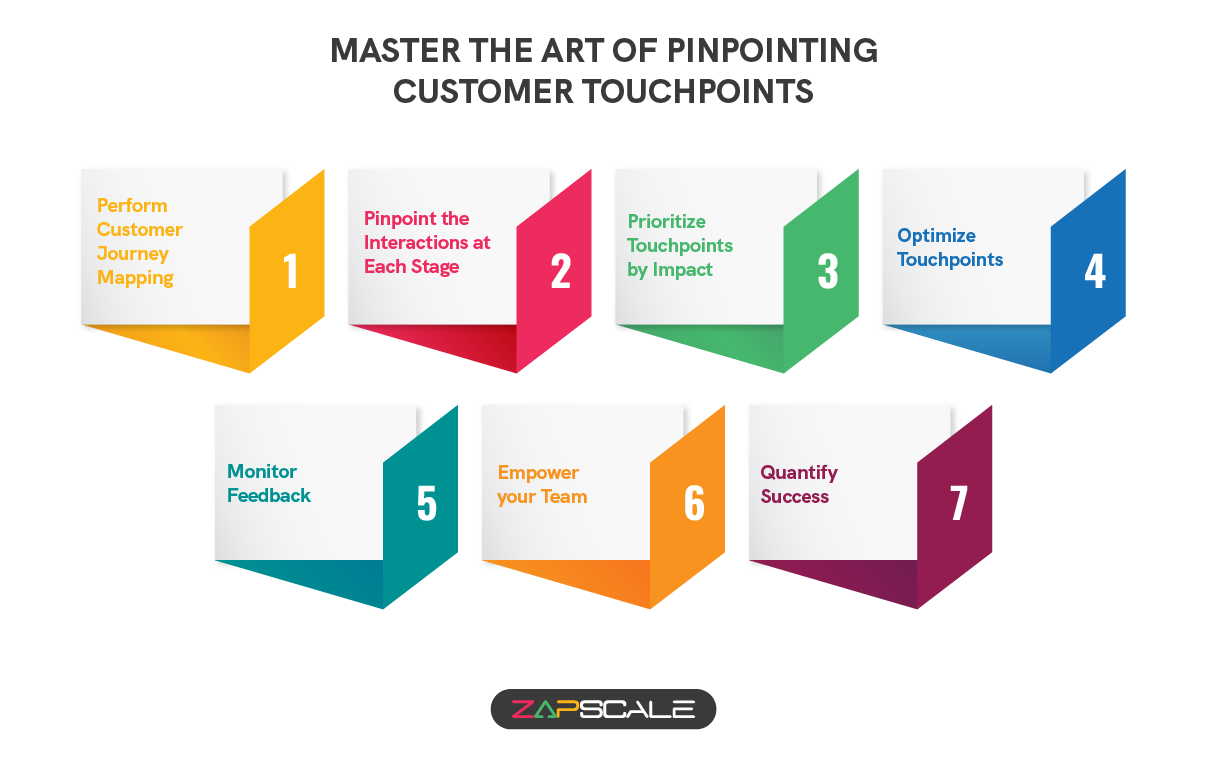CATEGORY > Customer Experience
What Is Customer Touchpoint? How To Identify Them?

In today's digital world, every customer touchpoint is a chance to ignite brand loyalty.
Let’s learn how to transform these touchpoints from forgettable clicks into unforgettable experiences for your esteemed customers.
Understanding Customer Touchpoints
Customer touchpoints are critical interactions, both direct and indirect, between customers and brands.
Every connection a customer has with your business, from viewing an advertisement to obtaining assistance after purchase, is a touchpoint.
They occur before, during, and after a transaction, influencing views and loyalty.
Each touchpoint shapes the customer's experience in the same way as personal relationships do.
Positive experiences at every stage are critical to building loyalty and driving repeat business.
These experiences shape their perception, just like dates in a relationship.
Make them positive, and you will gain loyalty.
If you’re running a SaaS business then you require more positive and engaging customer touchpoints than ever before.
Why? It’s because SaaS business models are more likely to lose customers than their counterparts.
Furthermore, customers frequently share unfavorable experiences on social media, which unfortunately sabotages a brand's good name.
Hence, ensuring great interactions at all touchpoints is critical for retention and brand reputation management.
Examples Of Customer Touchpoints
Customer touchpoints are critical moments when customers connect with a brand, influencing their perception and loyalty.
Here are some key instances to confirm the same.
1. Website
A well-designed, user-friendly website is frequently the initial contact point.
It should offer clear information, simple navigation, and rapid access to support.
2. Onboarding Process
Customer onboarding refers to the initial experience that customers get when they set up and begin using a product or service.
Clear guidance and support during onboarding can have a major impact on customer satisfaction and loyalty.
3. Customer Support
Whether by phone, email, or live chat, great customer service answers difficulties quickly and courteously, leaving a positive impression.
4. Social Media
Engagement on platforms such as Twitter, Facebook, and Instagram allows firms to communicate in real-time, exhibiting personality and effectively creating customer relationships.
5. Product Or Service Experience
The actual use of a product or service is an important touchpoint. It should keep its promises, be intuitive, and exceed expectations.
6. Email Newsletter
Well-crafted emails can deliver valuable content, updates, and targeted offers, keeping customers informed and interested.
7. Post-Purchase Follow Up
Sending thank-you emails, soliciting feedback, and providing support following a sale demonstrates a dedication to customer happiness.
8. Community And Events
Hosting events or attending industry conferences strengthens ties and creates a sense of community around the business.
9. Mobile Apps
Businesses with apps must provide a seamless and user-friendly experience on mobile devices.
10. User Reviews And Testimonials
Positive reviews and testimonials from satisfied customers act as powerful social proof, influencing potential buyers' decisions.
11. Surveys And Feedback Forms
Actively seeking feedback through surveys or feedback forms helps businesses better understand their customers' demands and problem spots, allowing them to enhance their offers.
12. Referral Programs
Referral programs encourage satisfied customers to suggest friends and colleagues, which can assist acquire new customers while leveraging existing customer loyalty.
13. Customer Success Manager
Proactively assist customers in achieving their intended goals through continual coaching, training, and support ensures long-term satisfaction and loyalty.
Key Customer Touchpoints For An Exceptional Customer Experience
Customer touchpoints are neither easy nor difficult to find, and they vary depending on the intricacy of the organization.
While some are simple for physical businesses, some involve additional analysis for other businesses such as digital platforms or customer service interactions.
Let’s tell you more about how you can pinpoint those customer touchpoints like a real genius.

1. Perform Customer Journey Mapping
Mapping the customer journey is crucial for understanding and enhancing the customer experience.
It starts with tracking how customers first encounter your brand, whether through online platforms like websites and social media or through physical interactions such as visiting stores or engaging with customer service.
Each stage like awareness, consideration, purchase, product/service use, and post-purchase is meticulously analyzed to identify pain points and opportunities.
This comprehensive view allows businesses to optimize touchpoints, streamline processes, and ultimately foster customer loyalty by consistently delivering exceptional experiences.
2. Pinpoint The Interactions At Each Stage
Once you've created a clear customer journey map, go further into each stage to uncover all possible interactions a customer could have with your company.
These interactions might be anything that helps your customers engage with your brand.
For instance, viewing a social media advert, browsing your website for products, interacting with a chatbot for information, contacting customer care for assistance, reading online reviews posted by other customers, or receiving a personalized email with post-purchase recommendations.
3. Prioritize Touchpoints By Impact
Not all customer touchpoints carry the same weight.
Analyze each encounter to better understand its impact on customer decisions and overall satisfaction.
This research takes into account the frequency of touchpoints, their emotional value, and their role in forming the overall customer experience.
Businesses that identify and focus on high-impact touchpoints can effectively deploy resources to improve customer happiness and loyalty in the long run.
4. Optimize Touchpoints
Improving the effectiveness of each touchpoint entails boosting usability, speed, and customization.
It's worthwhile to improve each touchpoint by making it more user-friendly, quick, and personalized to individual needs.
Streamlining processes such as checkout decreases friction, whereas tailored recommendations based on browsing history boost relevance and engagement.
This emphasis on usability, speed, and personalization increases consumer engagement and satisfaction at every stage of the experience.
5. Monitor Feedback
Monitoring interactions and gaining feedback reveals potential for improvement.
Analytics for measures such as conversion rates and satisfaction scores enable proactive adjustments to touchpoint optimization.
However, brands must also acknowledge indirect touchpoints, such as word-of-mouth, that influence perception.
Accepting open feedback promotes alignment with customer requirements, increases total touchpoint efficacy, and mitigates the negative effects of uncontrolled touchpoints.
6. Empower Your Team
To excel at customer touchpoints, provide employees with extensive training, clear policy communication, and a great business culture.
Engaged and knowledgeable employees are essential because they represent your brand during in-person interactions, ensuring that every touchpoint communicates professionalism and caring.
This dedication improves the whole customer experience by encouraging loyalty and favorable word-of-mouth.
7. Quantify Success
Establish clear KPIs, such as net promoter score or customer effort score, to assess the efficacy of customer touchpoints.
Regularly evaluating these data yields insights into touchpoint performance, directing strategic modifications to improve the overall customer experience.
Businesses can create loyalty and pleasure by concentrating on key touchpoints, such as initial interaction and post-purchase assistance.
How Do Customer Touchpoints Stand Out?
Customer touchpoints matter a great deal, specifically when you’re running a SaaS business in this saturated market.
Let’s find out how a positive customer touchpoint journey can contribute to SaaS success.
1. Drives Brand Loyalty
Delighted customers are returning customers!
Positive touchpoints along the customer touchpoint journey help keep your brand on the top of your mind and foster long-term relationships.
Personalized birthday greetings or exclusive offers following a transaction express appreciation and make customers feel cherished.
Positive touchpoints also promote customer advocacy, causing users to suggest your business to friends and family while fostering brand loyalty.
2. Maintains Consistency
Consistent branding and messaging across all touchpoints, including social media, advertising, in-store experiences, and customer service interactions, contribute to strengthening the brand's identity.
This unified approach builds confidence in customers and familiarity, guaranteeing a uniform experience throughout all interactions.
3. Fosters Personalized Customer Experience
Personalization through touchpoints makes customers feel valued and understood, which leads to better connections.
For example, you may browse an online store and receive product recommendations based on your past purchases or browsing patterns. This type of customization displays that you regard each customer's desires and preferences while making the shopping experience more relevant and engaging.
Furthermore, personalized emails with special offers or birthday greetings may be viewed as a caring gesture, which overall strengthens the customer relationship.
4. Maximizes Customer Lifetime Value
Creating a loyal customer base boosts customer lifetime value, resulting in long-term success for your business.
Long-term value comes from satisfied and returning customers.
Focusing on positive touchpoints throughout the customer experience promotes repeat business and fosters long-term relationships.
If a customer consistently has positive interactions with your firm, they are more inclined to return, try new products or services, and become brand ambassadors.
5. Adds Competitive Differentiation
Amazing customer interactions set your brand apart by continually providing outstanding experiences.
This includes creative solutions, exceptional service, and one-of-a-kind services that increase customer loyalty and brand reputation.
Prioritizing flawless customer journeys across all touchpoints, such as user-friendly websites and responsive customer service, has a huge influence on customers' decisions to choose your brand over competitors.
Optimizing Digital Touchpoints For Seamless Customer Journeys
Digital touchpoints are an integral part of any customer touchpoint journey so they must be taken into account for improving customer delight.
Here’s how you can ensure seamless digitized experiences for your precious users.
1. Seamless Multi-Channel Experience
Maintain uniform branding and messaging across all platforms (websites, social media, mobile apps, emails). Unified design features foster familiarity and trust, establishing brand identification and fostering customer loyalty through consistent customer experiences.
2. Personalized Content Recommendations
Use data analytics and customer insights to recommend products or content based on each user's interests and previous interactions.
3. Optimized Mobile Compatibility
Ensure that websites and apps are user-friendly on mobile devices.
Prioritize lightning-fast loading times and consistent display across several screens.
This improves accessibility and usability for people browsing, shopping, or interacting on smartphones or tablets.
4. Proactive Customer Support
Provide immediate assistance through live chat, chatbots, or AI assistants for quick issue resolution.
These solutions improve satisfaction by responding to inquiries quickly and eliminating customer journey disruptions.
FAQs
1. What are customer touchpoints?
Customer touchpoints are interactions between customers and a brand, including website visits, social media interactions, and more.
2. How can I use customer touchpoints to address negative experiences?
Use surveys or follow-up emails to solicit feedback on unfavorable encounters. Respond quickly with empathy and solutions to successfully rebuild customer trust.
3. What are certain KPIs to measure the effectiveness of touchpoints?
Key performance indicators such as net promoter score and customer satisfaction score can assess touchpoint effectiveness and provide recommendations for improvement.
4. What are some economical ways to improve customer touchpoints?
Train employees to be courteous and informed, customize greetings, and send handwritten thank-you notes post-purchase for enhanced customer experience.
5. What role do customer testimonials play in touchpoints?
Customer testimonials serve as social evidence, influencing possible purchase decisions and shaping brand impressions.
ABOUT THE AUTHOR
Sonali is a social media enthusiast and creative content writer with 3+ years of experience. With a passion for storytelling, Sonali delivers content that inspires, informs, and captivate readers.
Popular from Customer Experience
Quality Content,
Straight To Your Inbox!
Subscribe for the latest blogs, podcasts, webinars, and events!

Write a Blog
If you have experience in CS and
a flair for writing, we’d love to
feature you.
Write to us on
hello@zapscale.com




